Katy Perry’s Horrible Music Cannot Be Turned Off: The Terrible, Degenerate Music Other People Listen to Matters
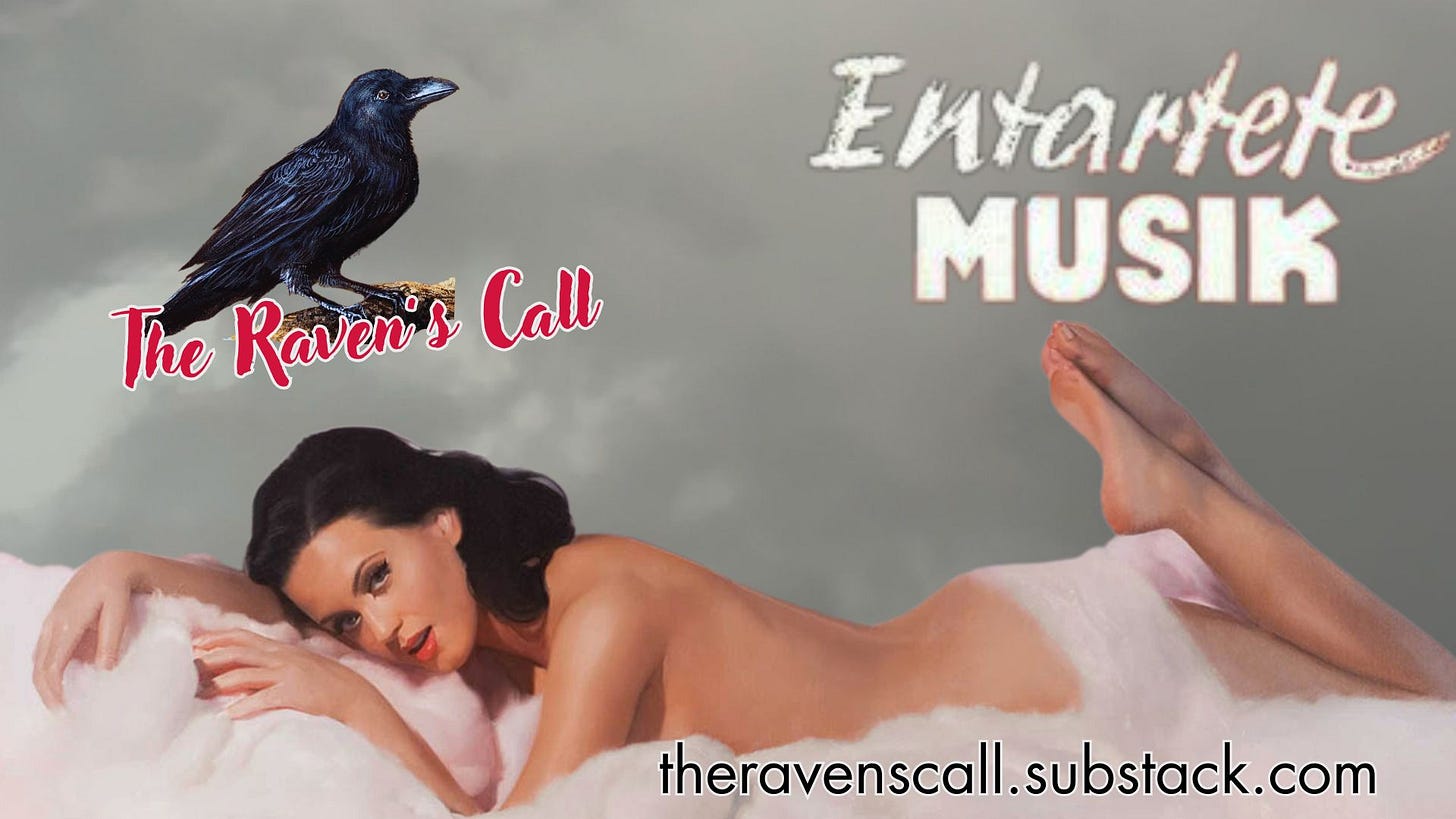
Author’s note: The caption “Entartete Musik” featured on this and other images means “degenerate music.” This along with greater condemnations of degenerate art were a prominent platform position of a certain political movement in the past. Some readers may recognize the stylized lettering from a certain progpaganda poster as well.
The cultural milieu any individual and society are immersed in is all encompassing and, in many important ways, inescapable. This pertains to so many aspects of modern culture: film, television, streaming, social media, and other forms of media. But it is perhaps no truer than in relation to music, particularly popular music. Just as there are so many facets of American Unkultur I despise with every fiber of my being, such contempt and disdain is exacerbated by how utterly inescapable so many of these elements are. I resent knowing who the Kardashians are, just as I resent knowing who Taylor Swift, Cardi B, and Katy Perry are. And with the announcement that this “artist” will be performing at the half time Super Bowl at the end of the football season, I now resent knowing who “Bad Bunny” is, or at least being familiar with his moronic stage name, and I do so without yet having been afflicted with what horrible “music” he or—more precisely—the studio executives, producers, and other handlers have doubtlessly created. And yet sentiments similar to “I resent knowing who any of these people are” all too often elicit a tiresome and utterly mindless response: namely, “Why would you care what other people listen to?” The reasons are as varied as they are obvious, and yet it is a concept that remains far too elusive to far too many. This essay will set forth some of the reasons why any sensible person should and invariably does care about the music others listen to, and how no one can just turn it off, at least not at an individual level.
As a key, integral component of the cultural milieu that envelops one and all, popular music promoted by advertising and mass media is largely inescapable. This belies the blithe but equally inane assertion that “if you do not like it, just turn it off,” “do not listen to it,” or other ridiculous responses to sensible protestations against modern “music” and American Unkultur more broadly. Obviously, to some degree, an individual does have a choice as to what he listens to, but that choice is far more limited than conventional wisdom supposes. Any number of scenarios in modern life involve situations where a person is a captive audience to music he rightly detests. A person can be shopping at a grocery or drug store and some horrible song comes on. Comedian Jim Florentine has a whole series in his podcast lamenting being exposed to what he regards as “Awful 80s Songs.” Readers with more agreeable taste in music may not agree with each and every song from the era he lambasts and ridicules, as some (but certainly not all or even most) popular music from the 80s is fairly listenable. But the general principle that the public is a captive audience to the music played in establishments open to the public nonetheless rings true.
How many have been shopping for groceries, sitting at a restaurant to enjoy a meal, fetching a modern car ride service, as well as engaged in other day-to-day activities before being suddenly exposed to “California Gurls” by Katy Perry, replete with its infamous, out-of-tune “millennial whoop” refrain that is not only grating but will remain in any person’s brain for hours or even days afterward: note hereinafter the word “girls” will be spelled correctly, as this publication will not abide the further degeneration of language at the behest of such pariahs. One time at a restaurant, that very song came on and I politely excused myself and pretended to take a phone call until the cursed auditory affliction had ended. In a grocery store or other shopping settings, however, such remedies are often not available. A person cannot just abandon a shopping cart or hand-basket and leave the store as quickly as possible, particularly if there are perishables among the items selected. The only choice is to sit (or stand) and take it. An Uber driver can be asked to turn off the music, but not all will comply. Or consider staying at a sprawling Scottish hotel and estate that just happens to have booked a wedding reception and the DJ, among other unfortunate selections, plays “Wannabe” by the Spice Girls at such a volume that it is even heard at a distance during a stroll through the estate gardens.
Other songs that are unpleasant to the ear include “You Got the Look” by Roxette and “Sussudio” by Phil Collins. On account of the finale of the somewhat overrated but still commendable series The Sopranos, the American public in particular has been subjected to a heavy barrage of “Don’t Stop Believing” that only subsided after a decade of it being constantly played in various public settings, although it is still regrettably heard somewhat regularly. Many of these songs although terrible are not nearly as bad as more modern fare.
By the same token, many of these horrible songs are admittedly matters of personal preference.1 A lot of the bad music, particularly music produced and peddled in recent times, transcends beyond mere personal preferences, however. Matters of art, music, and literature are often subjective, but some things go beyond that and are objectively awful. Consider for example how steak is prepared. Different persons may have different preferences for rare, medium rare, or medium, but medium well and above all “well done” steak is a ruined steak, and there are objective criteria that bolster this assertion:2 a “well-done” steak is dry, tough, and without flavor. The same principle applies to music. Children of the 80s, such as myself, will have different proclivities for different genres of music with each having its advantages and disadvantages. Some might prefer heavy metal, whereas others prefer indie-alternative, goth, and industrial as an expression of rebellion against the mainstream. But “Sussudio,” “We Built This City,” and other “earworms” are objectively awful.3 It may be difficult to identify and articulate what such objective criteria with precision, but they do exist.
“California Girls” as a Case Study of Truly, Objectively Awful Music and Harmful Messaging
Unlike some of the awful music described earlier, so much modern popular music crosses certain boundaries that places such degenerate culture beyond matters of taste and even the objectively awful into the category of things that should simply not be tolerated at all. A proper assessment of “California Girls” by Katy Perry in relation to this question requires a critical examination of the lyrics, the music video, and other elements associated with the song. That assessment and critique reveals whether disdain for this horrid song is a matter of personal preference, something objectively awful but more or less harmless, or is in the realm of expression that is not only objectively terrible but is also harmful content that should not be tolerated in consideration of first principles.
At the outset, irrespective of any subversive or disdainful lyrical or imagery conveyed as a message, the song is truly awful. As with the constellation of gynocentric pop singers propped up by the recording industry, inducing acute estrogen poisoning on the public, the song and production is obviously choreographed by recording studio producers and executives, and the “canned sound” production renders this unmistakable to the trained or discerning ear. Indeed, whereas legitimate music artists came about on their own, productions like this are planned, directed, and choreographed by the recording industry. One immediate “tell” of this is that Katy Perry did not write the song, it was “co-written” by committee, consisting not just of Perry and “Snoop Dogg” but Max Martin (real name Karl Martin Sandberg and the actual, real songwriter) and producers “Dr Luke” and “Benny Blanco,” real names Lukasz Gottwald and Benjamin Levin. As should be obvious to more discerning readers, the latter two are Jewish, an important fact that is by no means coincidental.

To further condemn this number as objectively awful, consider further how the refrain is a seemingly unending earache that likely has made some people’s ears bleed not only figuratively but literally as well. It is not only grating but is largely sung out-of-tune. Much worse, that horrible refrain has become known as the “millennial whoop.” Because of a unique propensity in human psychology to favor the familiar (better known as the mere exposure effect), and because this single proved so successful,4 recording studios have essentially mimicked that same refrain countless times over in various pop acts propped up by the industry since the release of this single. Indeed, the real, principal song-writer Max Martin (real name Sandberg) has written a plethora of hits for the league of mostly gynocentric pop stars that have infected what passes as popular “music” and American Unkultur more broadly. This propensity to offer nearly identical iterations of the same basic form of musical content has only worsened with the devastating effects that streaming and piracy have had on the recording industry. In response to these and other seemingly insurmountable challenges, the recording industry sponsors far fewer artists and even genres of music, concentrating its investment in a much smaller pool of artists that are more or less guaranteed to make money. Those artists are almost always the sort choreographed and staged by the industry, and its executives and producers. The lamentable success of this single and Katy Perry more broadly made this bit of induced ear-bleeding a veritable template, which has been closely mimicked if not copied whole cloth in a number of pop stars since. In this way, “California Girls” is not only a horrible song exceeding that of “Sussudio,” “We Built This City,” and other such auditory afflictions, it is the very nexus of modern era “musical” schlock, from which a million clones closely mimicking its progenitor have exploded and burst into the stream of culture and society at large.
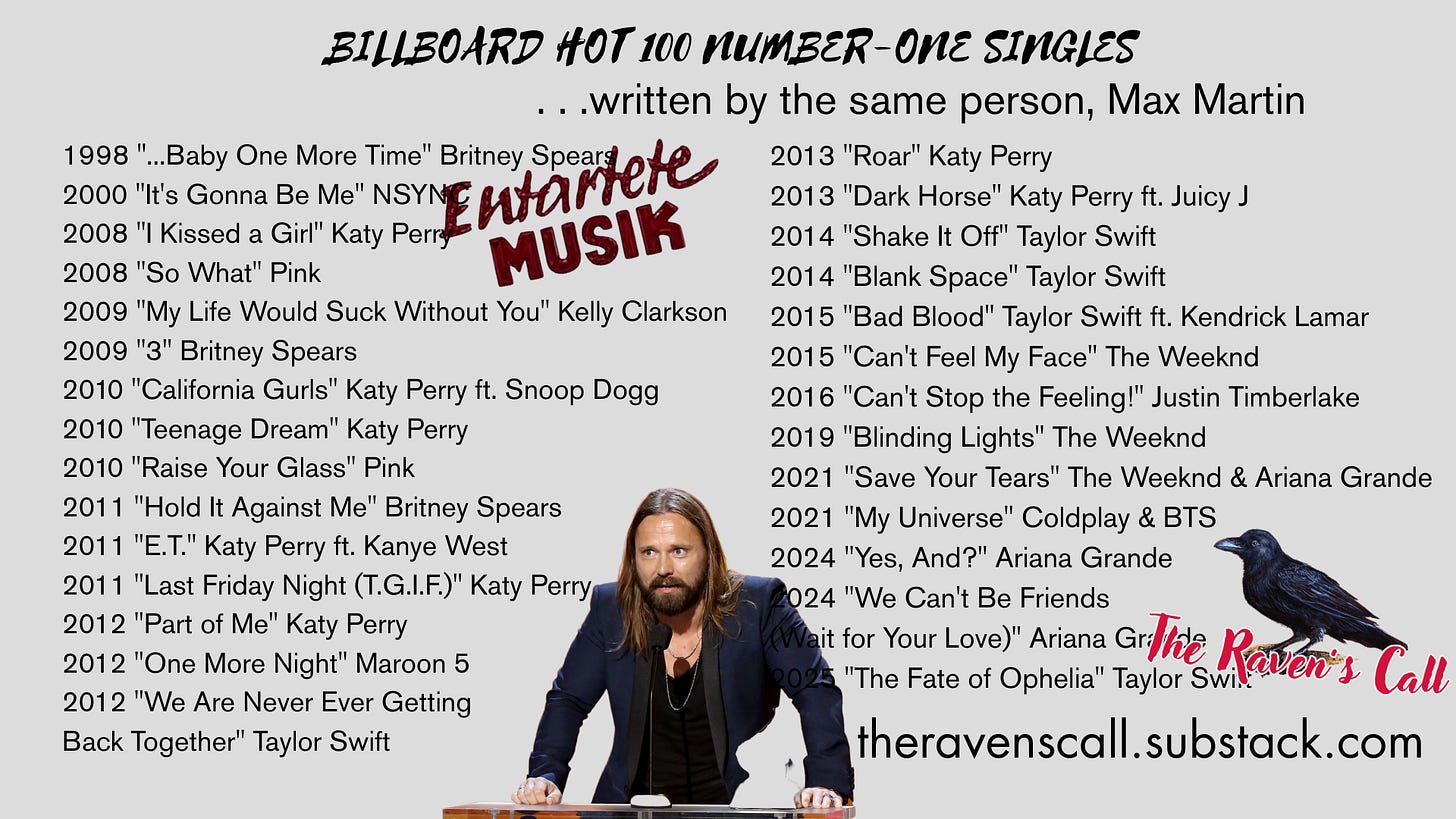
Some might contend the song and others like it are nonetheless harmless, in the same way a despicable cretin who eats a well-done steak is (more or less) harmless—that the song is simply a matter of taste, even if objective, universal criteria inform that the song is objectively horrible, in the same way that a “well-done” steak and “Sussudio” are horrible. A critical examination of the lyrics and most especially the music video however implores otherwise. Many phrases in the lyrics reveal how this song normalizes not just promiscuity but hyper-promiscuity. “We’ll melt your popsicle” is an obvious allusion to bringing a man (or men) to climax. Then there is this stanza:
Sex (sex) on the beach
We don’t mind sand in our stilettos
We freak in my Jeep
Snoop Doggy Dogg on the stereo, oh-oh
This is bolstered even further when placed in the greater context of other songs by Perry, including “Last Friday Night (T.G.I.F),” which includes the line “Skinny dipping in the dark then had a ménage à trois.”
These lines speak for themselves, although two things should be stressed. It cannot be argued that either the lines “sex on the beach” or how “we freak in my jeep” is imagined in the context of a loving, long-term relationship, or even a relationship at all.
Far more egregious, however, the song normalizes and condones miscegenation in both subtle and overt ways. The last line is of course an explicit statement that the sorts of hot, highly desirable young women described in the song listen to and like black, negrocentric rap “music,” most especially including that of Calvin Cordozar Broadus, the rapper’s real name. It also serves as a double entendre of sorts, as the verb “freak” in black slang can mean to dance in a particularly suggestive, provocative way, but it can also pertain to lewd sex acts. Even worse than the goofy use of black slang and explicit allusions to listening to rap music, both the lyrics and the imagery in the music video pair Broadus with Katy Perry:
Katy, my lady (yeah?)
Look at here, baby (uh-huh)
I’m all up on ya
‘Cause you representin’ California (ooh, yeah)
Other stanzas allude to miscegenation more broadly, pairing Black men with, if not White women explicitly, the hot, desirable “California girls” more abstractly:
Homeboys bangin’ out
All that ass hangin’ out
Bikinis, zuchinis, martinis, no weenies
Just a king and a queenie
Since when are young White men ever “homeboys?” Indeed, while the video features a number of very attractive women, most of whom are White but with a couple of diversity party favors, Broadus is the only male. He is presented as the archetypal pimp from 70s blackspoitation fare.
The lyrics are also objectionable for advancing Ebonics, black slang, and just bad English, however silly these lines are. In addition to “freak in my jeep,” “Cause you representin’ California (ooh, yeah)” is one prime example. Then there is “West Coast represent”—properly stated as “The West Coast represents,” you illiterate, uncultured pigs. In many ways these corny lines smack of the sort of cringe-inducing efforts by square conservatives to seem cool with laughable attempts at mimicking black culture and rap “music;” the extreme sex appeal and desirability of Katy Perry seems to override this, proving once again that the most desirable women have life on difficulty mode: tutorial.
Those who have read “Living in the 80s” may balk that there is moral inconsistency afoot. How can someone denounce “California Girls” for moral dissolution when that same individual favors classic Duran Duran or other, for lack of a better term, pop new wave artists of the 80s as well as the more artistically serious artists that comprise indie alternative more broadly? Although tame by contemporary standards, it is indisputable that the lyrics of “Hungry Like the Wolf” are indeed salacious, particularly with the sound of a woman moaning, ostensibly in orgasm, at the end.
There are several problems with such objections. First, Duran Duran is actually good music.5 Admittedly, such favor for Duran Duran, as with any artist or genre of music tied to a certain era and generation, is largely predicated on being a child of the 80s, as explained at further length below. On the other hand, with the passage of time, younger generations who did not come of age during their peak also enjoy such music. Much of the music and lyrics of Duran Duran may be wanting of substance, as Robert Smith of The Cure famously lamented, but it more than makes up for that in both style and listenability. Preference (not nearly a strong enough word in this instance) for Duran Duran is not merely a matter of taste and personal preference, in the same way that disgust and disapproval of a well-done steak is not. But aside from the fact that “Hungry Like the Wolf” and other favorites by Duran Duran are so eminently listenable, and accounting for how favor to such music is largely predetermined by being born in a certain time and place as an American Gen Xer, there are several important distinguishing factors. The sexual desire Simon Le Bon sings about is really about desiring one woman: “Woman, you want me, give me a sign.” When he states “I’m on the hunt, I’m after you,” it is in relation to that woman, at least in that particular instance.6 Beyond that, such lasciviousness is described in a more genteel manner. The line “Mouth is alive, with juices like wine / And I’m hungry like the wolf” could not be more different than Katy Perry talking about “melting your popsicle,” particularly with explicit references to “sex on the beach” and how “we freak in my jeep,” to say nothing of her mimicking a blow job in various moments in the video. At around 1:05 into the music video, Katy perry quickly runs her mouth and face along her forearms in an upward vertical motion, and then, after very quick cutaways, is shown again mimicking giving oral sex, with her hands to her face as if holding a phallus while pushing her cheek out with her tongue, all with a quick wink to the viewer: it happens so incredibly fast most viewers might miss it and indeed screenshots can only be captured when played at one quarter to one half playback speed.


Everyone knows that “Hungry Like the Wolf” is about sex and sexual desire, but it does not contain words with an explicit, sexual denotation, whereas “sex on the beach” and “freak in my jeep” do. Nor does it contain clumsy, abrupt allusions with the subtlety of a chainsaw or sledgehammer. And while Robert Smith of The Cure and others have disparaged the lyrical content of many Duran Duran songs, as most of the lyrics are non-sensical or at least leave much to be desired, “Hungry Like the Wolf” is not one of them. The quality of the lyrical content of “Hungry Like the Wolf” is brought in even stronger relief when compared to Perry, particularly with its use of Ebonics and black slang appropriated from so-called rap “culture.” While Perry is yet another avatar for American Unkultur in all its brash vulgarity and ugliness, Duran Duran—with a certain elegance and style—remains quintessentially British, in a proper sense, by its very gestalt.
Some who oppose the moral dissolution and ugliness of the modern world may disagree, but there must be balance between stodgy prudery on one hand and abject profligacy on the other. What Le Bon and Duran Duran describe in “Hungry Like the Wolf” is a healthy and essential part of normal sexual desire, and indeed part of the Life Force. It is imperative for both the individual and society that young White men and women desire one another, with a mind for certain carnal delights, tempered by countervailing social mores stressing the importance of loving, long-term relationships and an emphasis on marriage. That is not to say such fare is not exceedingly decadent, but expressions like this Katy Perry song are far worse and indeed are so utterly egregious that they cross many red lines for all the reasons discussed above. The song embraces hyper promiscuity, and does so not by mere reference or allusion, but in explicit terms denoted in the plain language of the lyrics.
Beyond that, the interracial element condemns the Katy Perry song as something that is truly morally and ideologically anathema. Matters of race, including expressions promoting race-mixing, are not just a matter of preference, or something reasonable minds can disagree on. They are a matter of first principles. To the extent supposed “inalienable rights” exist at all, they certainly pertain to those rights of race, blood, and soil, which includes freedom from racial imposters like Broadus or the recording, advertising, and other well-moneyed “industries” pushing miscegenation, above all pushing miscegenation on gullible, consensus-driven White women and even adolescent girls and children through the hypnotic power of mass media and modern popular music.
It cannot be emphasized enough that the song and music video normalize miscegenation and multiracialism. This is done by pairing Broadus with Perry not just as a musical duo but as a mutual sexual interest, bolstered and reinforced by the lyrical passages cited above, most especially “homeboys.” Multiracialism is further bolstered by the contingent of women dancers in provocative attire accompanying Perry, most of whom are extremely attractive White women, interspersed with a handful of diversity party favors, notably one single, solitary Black woman. These elements notwithstanding, the song is unmistakably geared first and foremost to White women, particularly suburban middle and upper middle class White women, and more particularly White adolescent and even “tween” girls. This is demonstrated in many different elements of the song’s lyrics and the video. Consider the allusion to driving (and arguably having sex in) jeeps, a fairly expensive automobile for young people. Vehicles like a jeep are generally made available to a certain sort of very privileged young White woman, a daddy’s girl, who gets a brand-new jeep or comparable vehicle on her sweet sixteen. That reference, reference to “sand in stilettos” connote an affluent lifestyle that is most applicable to upper middle- and upper-class White women. Consider also the title of the album featuring this single: Teenage Dream.

Even for those who do not bother reading or listening to the lyrics, the video presents Broadus with Perry. She is seen dancing with him in a most suggestive way, while also “looking him over” with a desirous glance. One of the last segments shows Katy Perry along with several other girls buried in the sand along with Broadus, kicking their feet up and down. Such body language is an unmistakable sign of excitement, sexual excitement. These and other visual cues go well beyond subliminal programming, as the video explicitly and overtly links the likes of Broadus with Perry and the entourage of other hot women in her dance ensemble. It is also of note that this very same pairing, linking the likes of Katy Perry with some black rapper, was done yet again in a song called “Dark Horse,” featuring “Juicy J,” real name Jordan Michael Houston; the video depicts Perry as Cleopatra and features some of the same imagery indicating sexual desire between Houston and Perry.
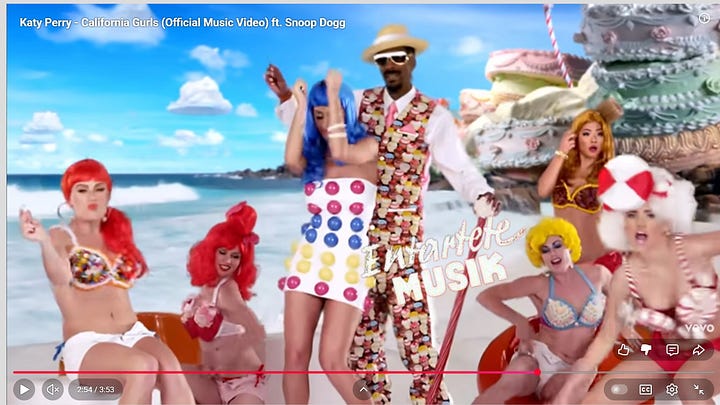

This matters because no matter how awful Perry’s music is and no matter how contemptible she is as both an “artist” and a person, it is indisputable that Perry was incredibly desirable in her heyday, and still is fairly attractive even in her 40s. As has been explained elsewhere by this author, women are consensus driven and are most influenced by whom they (in this and other instances) correctly perceive as the most alluring and desirable women. This phenomenon explains social proof also known as preselection, whereby women are not necessarily attracted to handsome or successful men, but are more precisely attracted to men desired by other attractive, desirable women. In plain terms, the video presents Katy Perry—who is (or was at the time) easily in the very highest echelon of female sexual allure—desiring Broadus and being receptive to his advances. Both the song and the video thus advance the insidious programming and indoctrination informing white women in particular that beautiful women like Katy Perry fuck black men.
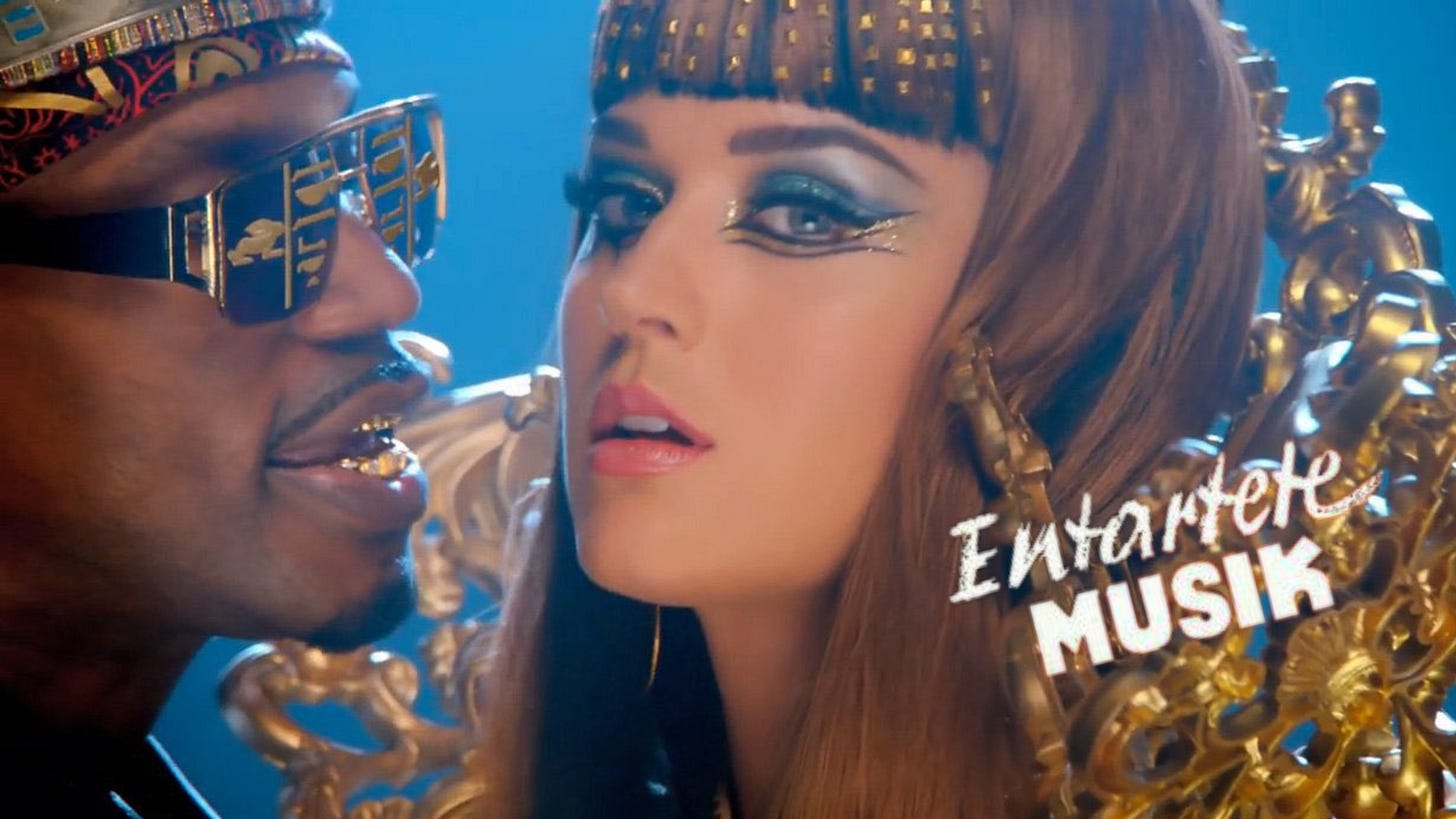
From Bad to Worse: A Spiral Forever Downward
In certain respects, musical fare such as “California Girls” is tame in comparison to a lot of “music” that now exists in modern popular “culture,” and that has been offered decades before. Those who have read “American Degeneracy Laid Bare” will recall how fourteen year-old blonde girls recited shockingly profane if not obscene lyrics by a black rapper. Those lyrics include lines like “7 bitches get fucked at the same time” and how he “can talk to a bitch / And get [his] dick sucked.” Readers of “What Consenting Adults Do Is Our Concern” will similarly recall the timeless, poetic lyrics of “Rules” by “Doja Cat:”
Said play with my pussy, but don’t play with my emotions (Emotions)
If you spend some money, then maybe I just might fuck ya (Fuck ya)
When I shake that ass, I’ma do that shit in slow motion (Motion)
Truly a poet laureate of our time.
Other lyrics by this “artist” are similarly profane. Consider “Cyber Sex,” with the line “Pussy all pink with a tan / And I play with it ‘til my middle fingers are cramped up.” Although somewhat less overt, the lyrics to “Juicy” are just as crass, even though profane language per se is avoided: “”He eat my fish like tekka maki, like a side of me with saké / So I put it in my mouth and suck it out like edamame, yeah.” Cardi B, another wonderous, mystery-meat specimen in a demographic that is becoming increasingly mongrelized and Africanized, is similarly infamous for the lines in “WAP:”
Yeah, yeah, yeah, yeah
Yeah, you fuckin’ with some wet-ass pussy
Bring a bucket and a mop for this wet-ass pussy
Give me everything you got for this wet-ass pussy
A further sample of these lyrics reads as follows:
Beat it up, nigga, catch a charge
Extra large and extra hard
Put this pussy right in your face
Swipe your nose like a credit card
Hop on top, I wanna ride
I do a kegel while it’s inside
Spit in my mouth, look in my eyes
This pussy is wet, come take a dive
This song features “Megan Thee Stallion,” who of course campaigned for Kamala Harris. The song “Intercourse” is similarly noteworthy, with a salient passage also encouraging marijuana smoking and excessive drinking as well as hyper promiscuity, all with the lewd crassness and abject vulgarity that is the hallmark of these “musical artists:”
Mixin’ weed with the liquor, creatin’ the chemistry
Takin’ shots back to back of the white Hennessy
I’m about what I say, so please do not tempt me, ayy
I’m so for real, I came no panties when he asked me to chill
I never gave a fuck ‘bout what them other girls sayin’
I just wanna know if the dick really hangin’
You ain’t gotta sugarcoat shit ‘less you’re lickin’ on me
If that’s the case, you need to get the liquor and the honey
Body right, pussy tight, come and put it on me
Sendin’ pics to your phone so you’re never lonely
Most recently, one Sabrina Carpenter—an attractive blue-eyed blonde and former Disney child star—has emerged as the latest female pop abomination, with similarly lewd, profane lyrics. Readers can peruse her lyrical content on their own, but it should be noted she has marketed a line of t-shirts, jerseys, and other apparrel with the name “Sabrina Carpenter” and the number “69.”
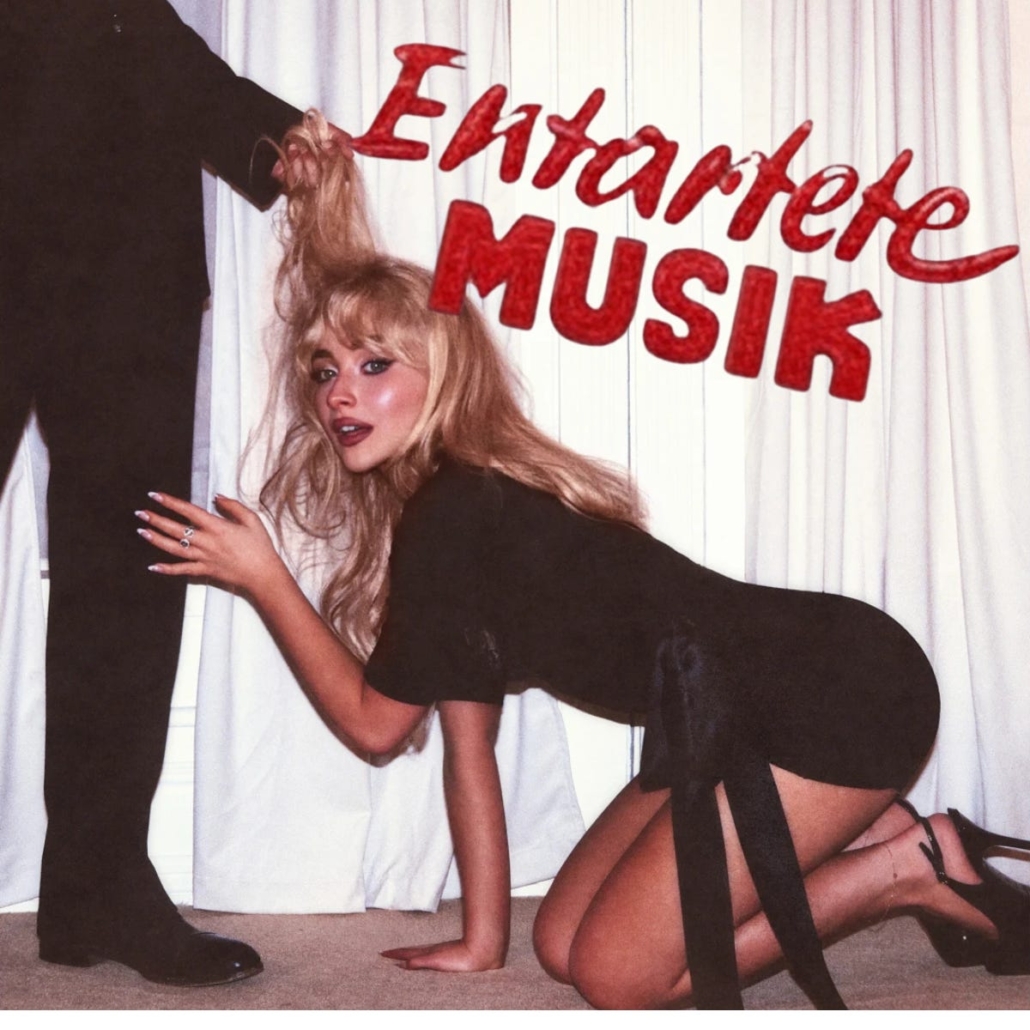 The cover art for Sabrina Carpenter’s album Man’s Best Friend, branded appropriately as entartet. The burgeoning pop singer is explicitly linked with race-mixing, like so many before. The producer is Jack Antonoff, of the same tribe as Gottwald and Levin.
The cover art for Sabrina Carpenter’s album Man’s Best Friend, branded appropriately as entartet. The burgeoning pop singer is explicitly linked with race-mixing, like so many before. The producer is Jack Antonoff, of the same tribe as Gottwald and Levin.These and other examples illustrate how tame “California Girls” is in comparison, but this may be reason to condemn the more subtle, less explicit offerings more vehemently. Several considerations inform this conclusion. First, the Perry single was released fifteen years ago. Despite its overt sexual allusions that are not just salacious but celebrate hyper-promiscuity, there was of course no meaningful response or reaction to these and other offerings because mainstream conservatism has been so incredibly inept and useless on matters of culture. And as is inevitably the case, society quickly became acclimated to such content, and deviancy was quickly defined even further down, as it always is.7 The failure to respond, in any meaningful or effective way, to offerings like “California Girls” or “Side by Side” by Ariane Grande8 paved the way for a new generation of figures in popular music, with content that is even more crass, more lewd, more profane; condemning such fare merely as utterly distasteful does not begin to describe the matter.
Beyond that, to the extent most pay little attention to lyrics at all, songs like “California Girls” are more effective and more dangerous because, in this idiotic society, so many fail to perceive these lyrics for what they are. In warfare, both soldiers and their hardware that are well camouflaged are, quite obviously, harder to detect and thus enjoy a much greater likelihood of the enemy being unable to react until it is too late. The same principle applies, in many ways, to subversive and degenerate cultural expressions in particular but really any written, visual, or multi-media work. That consideration informs why innuendo. double-entendre, allusion, and implication are so incredibly effective, both rhetorically and semantically.

As confounding as it may be to those both capable and inclined to read and understand song lyrics, this explains, at least to some small degree, why parents are taking young girls to see concerts featuring Katy Perry, Ariana Grande, and the like. As utterly inappropriate and shocking as that may be, parents do take young girls to see these and other artists, and have for quite some time. Indeed, there are even indications parents are taking young girls to see the aforementioned Sabrina Carpenter, even allowing young prepubescent girls to wear “Sabrina Carpeneter 69” apparrel.9
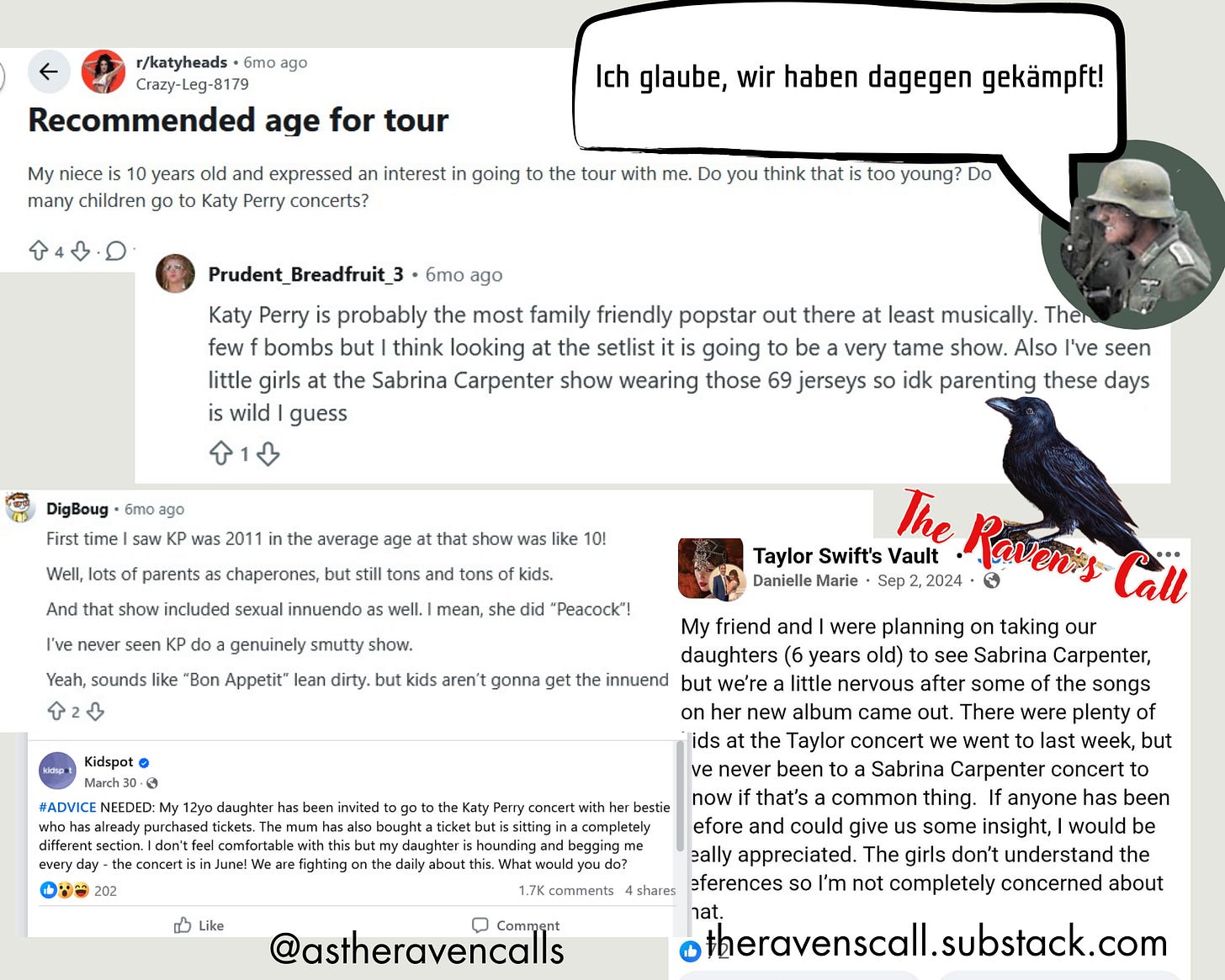
To suggest that “California Girls” is at all subtle or at all comparable to linguistic camouflage might rightly be met with ridicule and derision, but accounting for how passive and stupid much of the American public is, and when compared to the outright pornographic lyrics recounted above, such fare has proven capable of succeeding in mainstream culture with few sounding the alarms. Even today, most people are shocked by that moment in Lost Children of Rockdale County where fourteen-year-old girls recount such lyrics, all while playing with “stuffies” to demonstrate to the interviewer their familiarity with various group sex scenarios. As confounding as it may be, almost no one is shocked by “California Girls” and other portents of American Unkultur. This is true even though that song also promotes hyper promiscuity and race-mixing in ways quite similar to “Luv in Ya Mouth,” the song recounted by those fourteen year old girls in Lost Children of Rockdale County. That makes it and other similar fare all that more dangerous precisely because the masses are so complacent to indecent and profane lyrics and content, provided that such expressions do not venture into truly explicit or obscene language or imagery.
Just Turn it Off? No One Can Turn This Music Off
It should be self-evident that the suggestion to “turn it off” or simply choose not to listen to bad music is no solution at all. Even if such content were not played in public (much of it is in fact played in public settings with ubiquity), it is still in the stream of culture, and has been for some time. This is particularly true of the loathsome Katy Perry single in question. The popularity of that song and comparable offerings are not merely limited to slumber parties of teen and even “tween” girls lip-synching along to the scandalous lyrics with a hairbrush as a prop microphone. As unsavory as that prospect is, this sort of music is wildly popular among adults, particularly adult women. This shit music has lamentably become the soundtrack of our lives. And as modern Unkultur only devolves further, truly profane and obscene music is often played and overheard in public, and is so with increasing frequency. This includes instances where racial minorities, most especially blacks, blast their horrible music on Bluetooth speakers in various public settings as well as the worst music imaginable being played in eating and drinking establishments open to the public. Tolerance for ever increasingly vulgar and degenerate music and lyrical content only serves to normalize it, which then causes the masses to become acclimated to it. And tolerating it only defines deviancy ever downward.
Beyond that, music profoundly affects both temperament and mood as well as social norms and mores. The military traditions of Europe and indeed most civilizations in world history have long understood how music affects mood, which is why these traditions have embraced the power of music to instill fervor and zeal for war or, in times of peace, readiness for war. The composition of soundtracks for films and the way music is implemented in film and television demonstrates this further. Viewers will often interpret the same exact scene in profoundly different ways depending on the tone and temperament of the soundtrack being played along with the video footage.
Similarly, consider the central role “boomer rock” has played not only in shaping and defining the many mad delusions that have typified the baby boomer generation, but culture and society more broadly, across the Western world in the wake of American hegemony and the infusion of its insidious cultural expressions into European culture and civilization. How much of a role has “Imagine” by John Lennon played in convincing tens if not hundreds of millions of people in Europe and the Anglosphere that the mad folly and civilizational ruin of open borders is somehow a good idea? “Sex, Drugs, and Rock N’ Roll” is not only a buzzword slogan, but captures the ethos of much of the popular music of that generation (and succeeding generations to some degree), as that ethos is installed and programmed into the masses by the ubiquity of such music. Sensible persons may rightly detest both “Imagine” and John Lennon and other artists advancing the same contemptible creed, but that will not change what a profound impact that and other cultural expressions have had both on the “culture” and mainstream norms and mores. Simply refusing to listen to “Imagine,” to the extent that is even possible in an absolute sense (it is in fact not possible, as has been shown) changes none of this. Nor does personal aversion to Broadus—aka “Snoop Dogg”—detract from how he has been allowed—planned, even—to become a cultural icon, from sponsorships to Winter Olympics coverage to having his voice featured in ai voice generation services, to so much more besides.
In relation to both bad music that simply offends good taste but ultimately pertains to matters of personal preference as well as music that is truly repugnant for moral and ideological considerations, it is an inescapable axiom that the individual and society will be profoundly affected by the sorts of music embraced by large contingents of that society, and will do so in ways that are difficult to fully and perfectly appreciate or understand. This is particularly true of adolescent and young men in the sexual and dating and marketing place. Those who came of age in the 90s who rightly detest rap were almost invariably hampered in the dating and sex game by the sheer numbers of white women who do like this contemptible, negrocentric, vulgar filth. In current times, the same principle applies in relation to the numbers of white women who are not only fond of Taylor Swift but are zealous—militant even—in their patronage for the cultural and musical pariah. The number of such young women are seemingly legion. These and other such examples demonstrate how popular but undesirable music preferences of the masses will affect young men who balk at this and other garbage. The choice is to either feign amicability to such fare, try one’s luck by cavalierly and defiantly declaring “No, I hate Taylor Swift” or “I hate rap music,” or limiting one’s prospects to the ever diminishing pool of otherwise attractive women who detest such auditory and cultural afflictions. Further consider the ramifications of a society whereby college-educated women not only listen to Taylor Swift but read People magazine and various celebrity gossip rags, a culture, or rather state of Unkultur, where entities like Access Hollywood and TMZ not only exist but enjoy widespread popularity, even among those who are supposedly educated.10
The insistence that those who object should simply “not care what music other people listen to” or that “people who do not like it should just turn it off” is further undermined by the critical discernment that what is perceived as individual choice is far more limited than supposed by conventional wisdom. As explicated in “Thrust into It All: The Individual Defined by Culture and Circumstance,” the time and circumstance any one person is born into plays a much greater role in any person’s predilections and tastes than individual disposition or temperament. This is why young people who came of age in the roaring 20s were generally quite fond of hot jazz music, why teenagers in the silent generation generally liked “doo wap” and other popular music in the 50s, so on and so forth. Practically no one other than a certain segment of “The [NOT The] Greatest Generation” and older segments of the “The Silent Generation”11 can stand Lawrence Welk, let alone enjoy and seek out such sappy goofery with half-ass smiles and so much fra-le-lah-la-la; in fairness, many in that generation partial to more respectable big band and even jazz acts were not fond of such sickly sweet, childish whimsy that is not all that different than the inane children’s tunes sung by Barney the Dinosaur. It is the case however that no one born after about 1935 can stand that horseshit, thus proving again that the single greatest factor predetermining fondness or disdain for any artist or genre is the time, place, and era one is born into.
Further consider that people generally are drawn to what others like and what others do, and this is true perhaps most of all as it pertains to music. This is true of human psychology generally, but is particularly true of women who are consensus driven. The reasons explaining the “Swiftie” phenomenon are indeed confounding and impossible to understand fully, but much of it is explained by consensus driven conformity and the ad populum phenomenon. Indeed, Taylor Swift is a colossal psych-op in various ways. Consider allegations and rumors that her original single was propped up by her very affluent father who bought up 40,000 copies of her album to get her name on the charts. It is of note that these assertions persist despite concerted but unconvincing efforts to “debunk” or “fact check” them, just as it is of note that her father bought shares in the recording label. Whatever one concludes on that matter, the purchase of album and single copies to create the impression of popularity and consensus is a known tactic employed by various recording studios and executives.
Swift’s lamentable popularity has since been bolstered by a continuing and unrelenting advertising and publicity campaign, including the obnoxious manner in which NFL games featuring the Kansas City Chiefs constantly cut away to Swift and her entourage in a luxury booth whenever Travis Kelce, her then boyfriend and now fiancé12, would make even a nominal play. In accordance with the herd mentality, large numbers of people are susceptible to this. If they were not, the many billions expended in advertising campaigns would be a colossal waste of money. These and other considerations reveal that very often such regrettable predilections and taste in music is far less a matter of personal choice and much more about various external factors that envelop both the individual and society at large.
Beyond what one chooses to listen to by way of record or cd collection, streaming, or digital audio “hoarding,” that music which is prevalent in any given cultural milieu in a particular point of time is not only inescapable, but defines both that cultural milieu and that particular era and historical period in which it exists. Just as hot jazz music was an indelible part of the urban fabric in many American cities in the 20s and 30s, so the horrible music of today is an indelible part of the dreadful state of culture today. The manner in which music defines an era and a generation is well understood intuitively, even if only a select few can articulate how this is so. That very principle is exemplified by how the best cinema that uses music from a time period to convey that sense of time and place, from the music heard in 1955 Hill Valley in Back to the Future, to the selections chosen for different years and different eras in Goodfellas and Casino. This principle is also observed in films made in a particular era, such as Fast Times at Ridgemont High.
As with any other component of Kultur and Unkultur, music, as a cultural expression, has a profound impact on our social mores and mannerisms. Music, more so than perhaps any other facet of culture, has a profound, almost hypnotic effect on mood and disposition. A near universal celebration and love for genres and artists defines people and more particularly a generation. Similarly, more cultured and enlightened individuals and factions in a balkanized, fragmented, and dystopic society are only further alienated and estranged by the embrace of music that is rightly alien or repugnant to them. These and other considerations implore that what others listen to—that is what society as a whole listens to—matters, and matters a great deal. It matters in the same way that culture is so very important, all-pervasive even.
In this way, absurd suggestions such as “why do you care what music other people listen to?” or “just turn it off” are part and parcel of the same destructive ethos of indifference and hyper-relativism, imploring that the individual and society should not care about any elements of the cultural milieu in which everyone is intractably immersed in. It is the same, tired, and preposterous suggestion that no one should care about society or culture at all. This inane “argument” applies to so many facets of our daily life that stem from culture. No one should care, the argument goes, that people’s attire devolved from what it was in decades past to much of the abject slobbery so pervasive today. Or that smoking marijuana is not only legal but has become mainstream and thus seen as banal, just as no one should care about the myriad other vices and other destructive behaviors engaged in by individuals and society alike, that what “consenting adults do” is no one’s concern. Nor should they care that music has devolved in disastrous fashion. Instead of classical music and some of the genres enjoyed by both sides of World War II to some of the more respectable exemplars of 80s new wave and indie alternative, society is now defined by music that is not only god awful in terms of musical content but conveys any number of subversive, destructive messages, messages that are transforming and corroding social norms and mores for the worse. And society continues to devolve ever further downward in the absence of any meaningful response. Above all, the absurd suggestion insists that no one should care in the slightest that some of the most desirable and alluring white women have been weaponized against their own civilzation by these elments in the culture, both as figures in the constellation of pop stars producing such schlock and the legions of women who are hypnotized by these elements. As has been demonstrated time and again, nothing matters more than culture. Culture envelops all, and music is a key, integral component of culture’s all-encompassing power and influence.
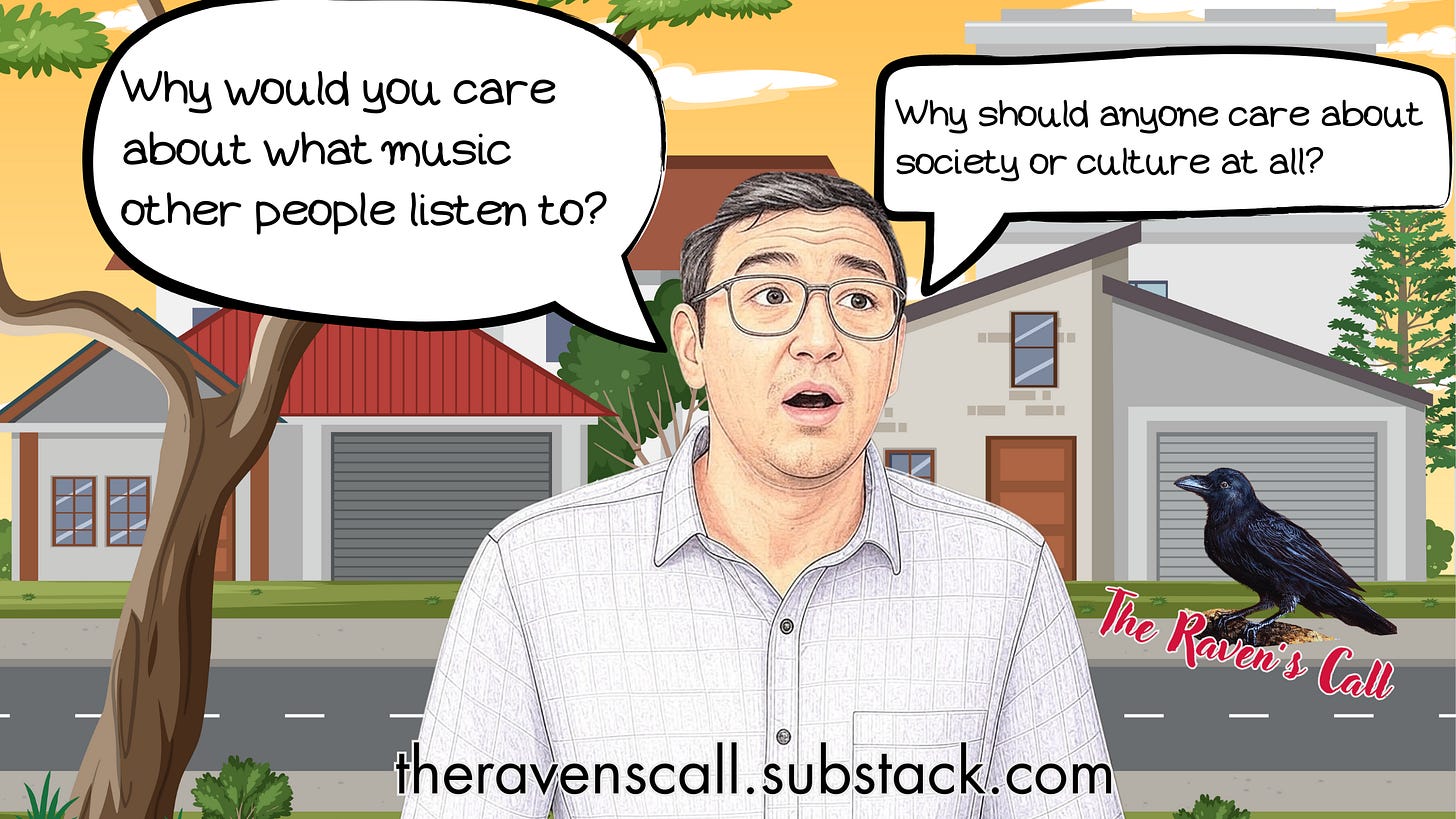
3 Once again, the precise particulars bound up in why and how this is so are beyond the scope of the essay, as such matters have defied precise articulation and summary by many of the great thinkers and critics of the ages. Some inditia as they relate to this song are of note however. First and foremost, both songs have not withstood the test of time, and were even disliked by some when they were released. Both are reguarly featured in lists of the worst songs ever. “Sussudio” is regularly chastised and ridiculed by Jim Florentine and other comics. “We Built This City” is regularly featured as the first in such lists of worst songs of all time. This is not entirely dispositive, as many of these critics laud other horrible music.
Both songs have meaningless—and awful—lyrics that have similarly been chastized and ridiculed, but that cannot be all of it as both Duran Duran (lyrics are not awful but often not great either ) and Cocteau Twins (whose music really has no lyrics at all) prove. It is also indicative that “We Built This City” is probably the single greatest exemplar of selling out, remarkable even for the baby boomer set that that ensemble was a part of. The same singer, Grace Slick, was, of course, behind “White Rabbit,” a hippy baby boomer anthem for drug use and 60s culture. Unlike the other modern pop songs afflicting us that are objectively awful, disdain for that song stems from personal preference and ideological and moral reasons as the song; as much as I dislike it personally, the song has musical and artistic value and was written and composed from a legitimate artistic, creative process. “We Built This City” was not written out of such a process, but was written and choreographed simply to make a hit, to make money. Slick even stated she hates it but sings it (or did sing it) because people liked it at the time. Another indicator that that song is objectively awful is that it is almost never heard among the many auditory afflictions that plague public life because it is disliked even by the lemmings among us.








Another interesting article as always
K-pop is even worse. Easily the worst music manifestation a jewish controlled society has ever produced. We were in a sushi place that had it on a projection screen. I still feel damaged but the sushi was too good to leave.
I mean Mr. Parker no disrespect in writing that if his article had included only half of its sordid examples, its several points would still have been made effectively—and moreover with far less stress on an “unentartete” reader’s sensibilities.
Clearly, one of those points is that so-called pop music has fallen a long way from the very mildly risqué …
… to its present state of proudly obscene bluntness.
________
P.S. A correction: Contrary to what is written in one of the captions, “Summertime” is not a “timeless blues song.” Although it has become what some pop-culture types like to call a “standard,” it is, strictly speaking, a soprano aria sung in act 1 of the opera “Porgy and Bess.” Its composer was George Gershwin (a homosexual Jew), and its librettist was DuBose Heyward (a straight rich white Gentile who insisted—and duped himself into believing—that blacks could be transformed into moral, law-abiding, cultivated citizens if only they were given sufficient money, jobs, and sympathetic understanding).
if his article had included only half of its sordid examples, its several points would still have been made effectively—and moreover with far less stress on an “unentartete” reader’s sensibilities.
Fair point, but with any luck this essay will reach those who need to see and read it the most. And unfortunately a certain quote from a classic film from the mid 90s holds true, not for you and people like you, of course, but certainly many people who need to read this essay:
“Wanting people to listen, you can’t just tap them on the shoulder anymore. You have to hit them with a sledgehammer, and then you’ll notice you [have] their strict attention.”
It is a line I think about quite often, particularly as it is featured in a track by one of my favorite industrial, aggrotech artists. Notable as well because I have had to be on a music cleanse to get–and keep–that horrid Katy Perry song out of my head. It was creeping in just writing and thinking about it.
Thank you for your reply, Mr. Parker. I take your point and see its merit.
I think this type of music is called candy pop (or something like that).
Like sugar it is desirable, especially to the young.
But no self respecting person would produce it. Perhaps that’s the point. Like much else in modern pop culture- all forms of self respect and respectable behavior are to be abolished.
All very “learned elders of zion” stuff.
I fell in love with classical music at the age of 11. I’m nearly 50 now. It’s been a nonstop love affair ever since. As a result, I think all rock ‘n’ roll, jazz, heavy metal, and derivatives, are destructive garbage.
Henry Ford talked about the Jews of Tin-Pan Alley. What you wrote about here is no different except more depraved, more niggerish, and queer.
Only three paragraphs into this article but can already tell it’s going to be a fun one!
The elders were right, all along, in the mid ’50s when rock and roll exploded. It’s decades overdue to apologize to them and admit they were right
Yes, I recall reading about pastors railing against Elvis. Even before them, opinion pieces in the papers, in Louisiana, no less, were railing against the popularity of blackish dances like the Charleston. The intense infatuation with all things jazzy like Big Band, the Blues, etc., are really a blemish on the White collective.
It’s amazing how Western mores used to be more attuned to Islamic ones.
Triumph Of the Swill.
Back to the Electric Wizard and Darkthrone marathon.
Not available at Hot Topic.
Quite so. I am a musician and my first objection to this pop garbage is that it is not music played by musicians but noise put together by tinned eared technicians on computers. The lyrics are mostly incomprehensible to me and would be a monumental waste of my time to pursue. So I appreciate the author setting them out for me
Allow me one little nitpic here. Comparing today’s pop recordings to steaks that are actually completely cooked medium well and well done, is silly. If you don’t have a chef with the skill to cook a steak properly you had better find another chef.
The steak comparison may seem irrelevant or silly, but it is not. It is an easy to understand example showing how something can be at once subjective and objective. As I explained, a preference for rare or medium rare or perhaps even rare is subjective, something reasonable minds can differ on . A well done steak however is ruined, objectivlry do. And it does not matter if there are cretins who eat it that way.
In this age of hyper relativism, even that proposition has become controversial.
Thanks for your efforts to explain the degeneracy in Western culture, but I fear the West is a lost cause. The last hope for humanity to escape the Juden’s grip is the Han peoples, IMHO. The West is enthralled with the *Judeo*-Christian ethic, by which the Juden lead the Goyim around by the nose. Fortunately, the Chinese are not subject to influence from that direction. There is no “Judeo-Buddhism,” or “Judeo-Taoism,” or “Judeo-Confucianism,” etc. The Han are not susceptible to manipulation, subversion, or undermining of their culture by the Hebrew god – thank god! The Han are the last hope for humanity. At least, that’s the way I see it.